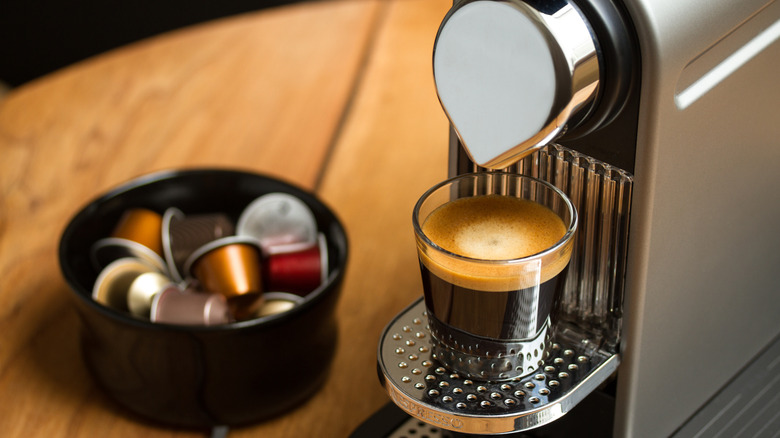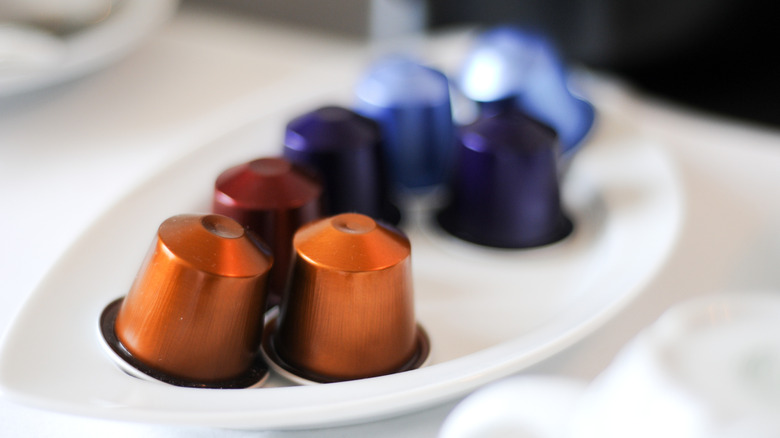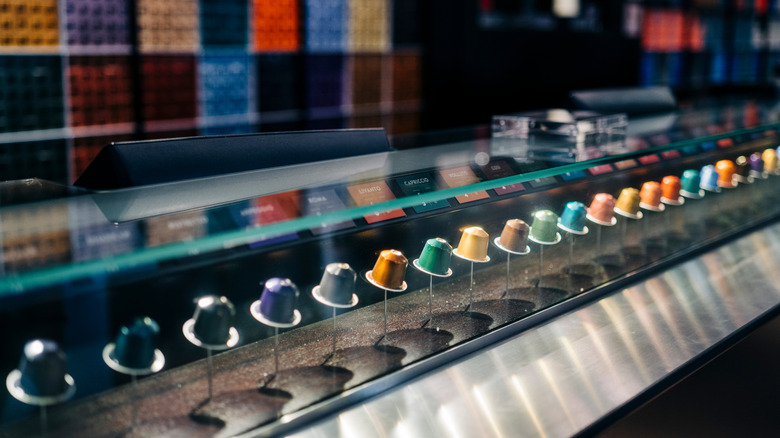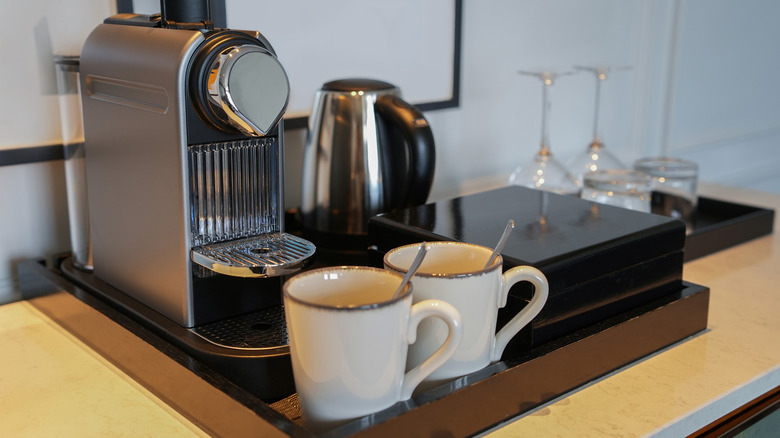13 False Facts You Shouldn't Believe About Your Nespresso
Nespresso machines are an exciting tool — in fact, they might just transform a part of your morning routine for the better. But even if you've enjoyed fast-brewing cups of coffee for a while, there might still be some things you don't know about your Nespresso machine. Maybe you've been tricked by false facts, third-party promises, or are just missing some key information about your machine.
If you're wondering how you can get the most life out of your Nespresso — or have just bought a new machine and are trying to figure out how to take care of it — you might also want to know about some common Nespresso myths. Whether you're a new or long-time Nespresso owner, you're bound to find out a thing or two you never knew about Nespresso before.
No matter your favorite Nespresso pod, understanding these false facts can help you keep your machine running for longer (and they might even help you make your morning brew taste a little better, too). We rounded up 13 false facts we think you should know about your Nespresso machine so that you don't make any mistakes when it comes to using and caring for it.
You can leave water in your Nespresso canister
Are you someone who likes to prep your Nespresso machine for the week by filling up the canister with water? It might seem like a good idea because the Nespresso canisters can hold a lot of water at once. Even though it's nice to not have to reload your machine with water every morning, filling your canister ahead of time isn't a good idea.
Bacteria begins growing in still water at room temperature quite quickly; it can take as little as one day for your drinking water to be contaminated. Once that happens, you risk getting sick every time you take a drink of your Nespresso's old water. Though the Nespresso machine itself will heat the coffee to a high enough temperature to kill bacteria, the coffee cycle may actually not run long enough to kill off all of the bacteria in your canister.
This means that if you don't fill up your Nespresso's canister with fresh water every day, you run the risk of getting an off-tasting cup of coffee — or even worse, getting someone sick. Filling it up the day of or night before is just fine — generally, water can sit out for 24 hours without risking any bad bacteria growing inside of the machine.
You can brew tea in your Nespresso
Some third-party pods market the idea that you can brew tea using your Nespresso. Of course, the Nespresso brand only offers coffee pods, which is why it might seem tempting to opt for a third-party pod if you're a lover of both tea and coffee. These third-party pods will offer a coffee alternative: a pod filled with concentrated tea leaves. Aside from there being potential to damage your machine when using third-party pods, even if you do vet the tea pod properly, you should know that doing so can make your drinks taste a little strange.
If you're hoping to brew both coffee and tea in your Nespresso, think again — both coffee and tea in the same vessel can affect each other's flavor, contaminating the natural taste of your typical morning brew, whatever that may be.
Additionally, you might be surprised to learn that a Nespresso machine isn't all that well-equipped to brew tea (there's a reason the company hasn't started its own tea line, after all). While many Nespresso coffees take well under a minute to brew, teas need to be brewed for at least a full minute (usually much longer) to achieve the flavor. Unless you're a fan of weak tea, third-party tea pods probably won't cut it.
Any third-party coffee pod will work
If you've been looking into reusable Nespresso pods or third-party pods for your machine, you might want to think again. It's best to buy directly from Nespresso when it comes to coffee pods — even though there are plenty of third-party offerings on the market, some of them do have problems. For example, certain third-party pods are made of plastic, which could cause them to melt in your machine and permanently damage it. Some Nespresso users have also had problems with smaller third-party vendors whose pods didn't brew correctly in the machine. Though this will get you a gross cup of coffee in the short-term, longer-term use of these pods have caused users to complain of clogged machines, trouble retrieving the pods from the machines, or even leaking.
If you're set on using third-party pods, we've ranked a few we enjoyed using. These pods also won't damage your machine when using them. Just be sure to carefully vet any third-party pod you plan on using before you buy it.
You should also keep in mind that Vertuo machines won't run third-party pods at all. Each Nespresso Vertuo pod uses a barcode on the pod of the machine to determine how to brew it; these barcodes can only be found on Nespresso-brand pods.
Third-party pods void your Nespresso warranty
So, maybe you've decided you can't help but try out a third-party Nespresso pod. You might think that doing so will completely void your Nespresso machine's warranty, but you'd actually be wrong. Nespresso's warranty will cover your machine no matter what pods you decide to use.
However, it is important to understand your machine's warranty before frantically buying up all the third-party pods you can get your hands on. If a third-party pod you buy does end up damaging your machine at some point, your warranty won't cover that damage. Merely using third-party pods won't instantly void your warranty — they'll only do so if the damage to your machine was caused specifically by a non-Nespresso brand pod. For example, Nespresso might notice that a third-party plastic pod has melted into your machine and damaged it — in this case, they wouldn't be obligated to cover your machine under warranty. But if your machine has a manufacturing problem, that's not on you; Nespresso will fix it under warranty.
We can't caution you enough to choose your third-party pods carefully based on their size, seal, material, and compatibility — but you can at least feel assured in knowing that, in most cases, you can still have your machine repaired under warranty should the need arise.
The Nespresso pods can be thrown straight into recycling
When you're finished with your morning coffee, do you throw your Nespresso pod straight into the recycling? If your answer is yes, you've likely been doing something wrong. Nespresso pods can't be recycled in many U.S. states unless they've been thoroughly rinsed out first, so think twice before you throw your pods in the blue bin. You'll first need to peel off the seal and rinse all of the grounds out of the pod itself.
Nespresso also offers a recycling program for all of its pods — completely free of charge. All you need to do is add a free shipping label to your cart the next time you shop online at Nespresso, save your pods after you use them, and then send them back. You can also drop them off at Nespresso collection points to be recycled. This allows Nespresso to recycle pods directly; even better than recycling your Nespresso pods yourself because Nespresso actually asks that you leave the grounds in your used coffee pod when returning them. The company says it uses old coffee grounds for commercial composting, so the pod program can be circular zero-waste if you choose. Another option is composting the grounds yourself, and then returning carefully opened pods via the Nespresso's pod recycling option.
You don't need to descale your machine
You might already be cleaning your Nespresso machine regularly. In fact, many machines self-clean so you don't have to. Descaling your machine is a different process, though, and one false fact about your Nespresso is that it descales automatically. It doesn't.
If you've owned your Nespresso for six months to a year, it might be time to descale. This removes limescale buildup from inside the machine, which over time, can be caused by a collection of minerals from the coffee pods. It's completely natural, and it's not necessarily harmful, but you will likely notice that it eventually starts to make your coffee taste odd. If your cup has a metallic, sour, or otherwise acerbic aftertaste, check the machine. The white, powdery substance inside is what you need to clear. Limescale can also impact the water flow of your machine and, if left long enough, can also grow bacteria.
To descale your machine, you can purchase a descaling solution straight from Nespresso's website. This typically only needs to be done every three months or 300 pods per Nespresso. You can also descale your machine if you start to notice visible buildup or just think your morning brew tastes a little strange.
You can't use your own coffee in the machine
If you're really, truly dedicated to creating your own coffee blend to use in your Nespresso, you technically can. It might not be easy, but for some, it's worth it. There are two main ways to do so. First, you can opt for a third-party reusable pod that is compatible with your Nespresso machine, and then fill it with the coffee grounds of your choice. Stay wary of the brand you purchase, as many third-party pods could potentially damage your machine over time.
Secondly, you can purchase third-party pod resealing tabs for your used Nespresso pods. After you've used your Nespresso pods, rinse them out, fill them with the grounds of your choice, and then reseal them yourself. This is a lot of effort, so only those who have a brew they absolutely won't compromise on are likely to take this route. An alternative (and easier) option for those who have a specific palette is to use Nespresso's website or stores to find a blend that has the most similar tasting notes to your favorite brew.
Any machine can take any pod on the Nespresso website
If you thought any Nespresso pod would work with your machine, think again. There are plenty of incredible flavors to choose from on the Nespresso website, but not all sizes of pods are compatible with every machine. Most pods will specify what machine they're designed for either in the name or in the description. Nespresso's website also allows you to shop by machine, so you can guarantee you're purchasing pods that your machine can take.
When purchasing, make sure you double-check each pod's description. Some pods — like the XL Nespresso pods, which can only be used by Vertuo machines — may include more information about which Nespresso models can take them. All Nespresso pods are delicious, but they're not all the same — so make sure the sleeve you're buying is compatible with the machine you have before you hit "add to cart."
Nespresso pods use plastic
Nespresso pods are made of aluminum. This makes them much safer to drink than other plastic pods (or pods that use some amount of plastic in them). Even plastic pods that are technically food-safe can actually cause significant harm over time when chemicals and plastic leak from the pod into your cup, which can happen once a plastic pod is heated by a coffee machine. Plastic pods have been linked to increased cancer risk, fertility issues, and gastrointestinal problems in the past. With that in mind, it's always best to avoid plastic entirely when you're purchasing coffee pods.
Every one of Nespresso's pods contains absolutely no plastic, so you can guarantee that harmful chemicals aren't compromising your morning drink. Not only are the pods completely recyclable, but the aluminum material also eliminates the potential for any contaminants. Unlike plastic, aluminum pods don't leak dangerous amounts of toxins into your drink when exposed to high heat. Additionally, all of Nespresso's pods are also BPA-free. This makes Nespresso pods some of the safest coffee pods to drink. This also means that they're a great pick for anyone who is worried about microplastics or harmful chemicals joining the ingredients list in their daily coffee.
Nespresso machines brew weaker coffees
All Nespresso machines are designed to take a concentrated pod and use a predetermined amount of water to prepare it. This means that the end result is a significantly stronger and oftentimes more caffeinated cup of coffee when compared to your average brew. Every step of the process is exact, from the grounds themselves to the perfect amount of water your machine is programmed to brew.
Though the caffeine in a pod starts at about 40 milligrams at the lowest, Vertuo pods can go all the way up to 200 milligrams of caffeine per pod. In comparison, the average cup of coffee will have around 80 milligrams of caffeine per cup. (If 200 milligrams sounds like a lot to you, note that some Vertuo pods are meant to serve two people — so you're more likely to find an average of 100 milligrams of caffeine per cup of Nespresso coffee). This means that Nespresso is generally anything but weak. If you want more powerful, flavorful coffee in your cup, Nespresso pods have what you're looking for.
You can leave your machine plugged in for long periods
Want to keep your Nespresso machine running smoothly for as long as possible? Of course you do. Whether you're heading out on vacation or just don't drink coffee all that often, it's best to leave your Nespresso machine unplugged if you're not a frequent coffee drinker. Unplugging your Nespresso machine before you leave the house for an extended period of time can prevent it from being damaged during a power surge while you're not there to keep an eye on it. Leaving any appliance plugged in during long periods away can also be a major fire hazard — just another reason to unplug your coffee machine.
Nespresso's user manual states that you should be unplugging your machine if you're not planning on using it for a while. So, when is it safe to leave your Nespresso machine plugged in? Nespresso recommends leaving your machine plugged in overnight between uses so that it can receive updates. With its energy-saving mode, doing this won't cost you any electricity at all — and your machine will be perfectly safe staying plugged in between regular uses.
You can leave your machine as-is during periods of non-use
If you use your Nespresso machine every day, you might not be unplugging it in between uses — and you might not be aware that there's an emptying process for the machine before it goes through periods of non-use, too. If you're planning on sending it in for service, heading out for vacation, or just want to make sure it's protected during a move, you should empty your Nespresso machine before you unplug it.
It's more than just emptying the canister or clearing out old pods — it's a cycle you need to run on the Nespresso itself to ensure that it stays clean or that its internal parts don't freeze up during cold weather when you're not using it regularly. Nespresso recommends emptying your machine if you're planning on leaving it alone for over a month (or if you're sending it in for service). That way, you can guarantee you'll come back to a machine that can be used straight away after a simple cleaning cycle.
Your machine can't take expired coffee pods
Did you know that Nespresso pods don't actually expire? Every pod has a best-by date that indicates when its flavor will be the most fresh. Generally, you'll want to consume your pods by this date to ensure that you get the most flavor and strength from your coffee. Otherwise, you might notice that it doesn't taste quite as good as it does normally. However, it's not at all harmful to consume pods that have passed the best-by date — and it's no issue for your machine to prepare them, either. If you have pods that have passed the best-by date that you don't want to waste, don't hesitate to use them all up before buying new ones.
Most Nespresso pods will have a best-by date of about a year after they've originally been manufactured. The pods they come in, however, will protect the coffee grounds inside from being exposed to any kind of light or oxygen, which keeps them perfectly sealed long after the best-by date has passed. Just make sure you haven't accidentally broken any of your pods during before you use them.













